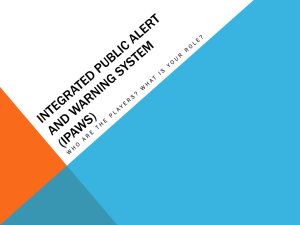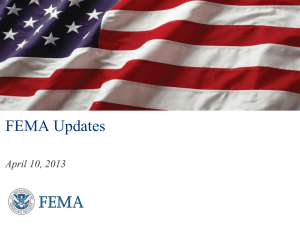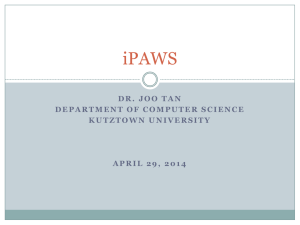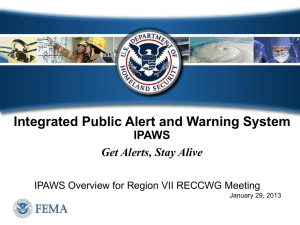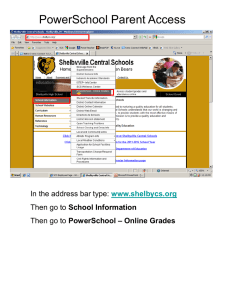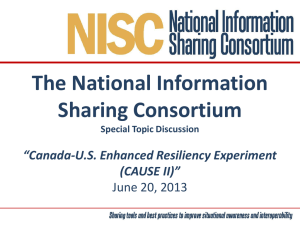Session 24_FEMAs Integrated Public Alert and
advertisement
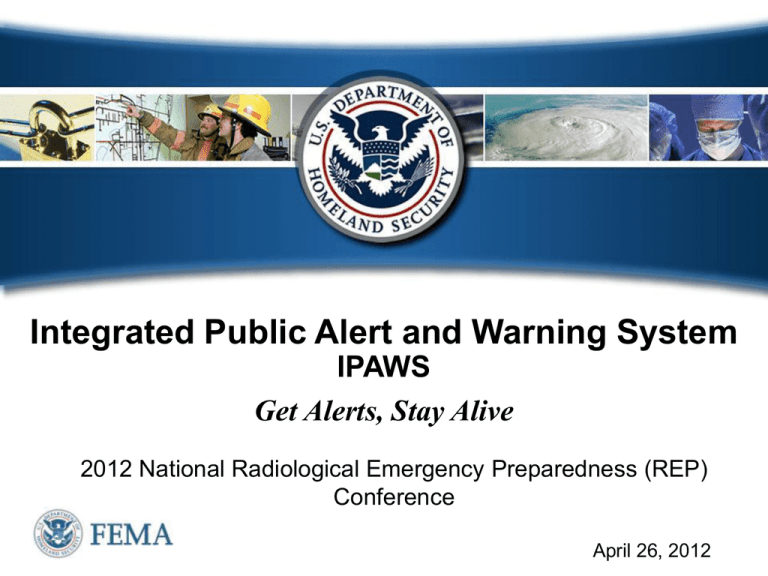
Integrated Public Alert and Warning System IPAWS Get Alerts, Stay Alive 2012 National Radiological Emergency Preparedness (REP) Conference April 26, 2012 The Evolution of Public Emergency Alerting 1951 - 1963 1963 - 1997 CONELRAD EBS Originally called the “Key Station System,” the CONtrol of ELectromagnetic RADiation (CONELRAD) was established in August 1951. Participating stations tuned to 640 & 1240 kHz AM and initiated a special sequence and procedure designed to warn citizens. EBS was initiated to address the nation through audible alerts. It did not allow for targeted messaging. System upgraded in 1976 to provide for better and more accurate handling of alert receptions. Originally designed to provide the President with an expeditious method of communicating with the American Public, it was expanded for use during peacetime at state and local levels. 1997 - - - - - - - - present EAS IPAWS EAS jointly coordinated by the FCC, FEMA and NWS. IPAWS modernizes and integrates the nation’s alert and warning infrastructure. Designed for President to speak to American people within 10 minutes. Integrates new and existing public alert and warning systems and technologies thru adoption of new alert information exchange format - the Common Alerting Protocol or CAP EAS messages composed of 4 parts: • Digitally encoded header • Attention Signal • Audio Announcement • Digitally encoded endof-message marker Provided for better integration with NOAA weather and local alert distribution to broadcasters Provides authorities a broader range of message options and multiple communications pathways original timeline info borrowed from: The Broadcast Archive by Barry Mishkind, The Eclectic Engineer 2 IPAWS Vision Provide Timely Alert And Warning To American People To Preserve Life And Property Integration of public alert communications systems: – One emergency alert message delivered to all available public channels – Easy to use for public safety/alerting authorities Improves and Enhances emergency alerting by increasing: – reliability that affected citizens receive an alert via at least one path – likelihood that citizens react to emergency alerts 3 IPAWS Architecture Standards based alert message protocols, authenticated alert message senders, shared, trusted access & distribution networks, alerts delivered to more public interface devices Alert Disseminators Alerting Authorities (public alerting systems) Local Territorial Federal* * Includes NOAA IPAWS compliant CAP Alert Origination Tools Emergency Alert System All Radio and TV AM FM; Digital, Analog, Cable, and Satellite Alert Aggregator/ Gateway IPAWS OPEN the Message Router (Open Platform for Emergency Networks) CAP messages Tribal Emergency CAP messages State American People Commercial Mobile Alert System (CMAS) cell phones NOAA HazCollect NWS web applications, widgets, web sites, social media Internet Services IPAWS compliant CAP Alert Origination Tools State / Local Unique Alerting Systems FM RBDS ETN Siren Digital Signage Future Technologies 4 IPAWS Capabilities Overview: • State/Local alerts sent thru IPAWS are distributed to: – – – – Local radio and TV stations participating in local EAS Cellular phones as Wireless Emergency Alerts (WEA) NOAA for broadcast over local NOAA Weather All Hazards Radio Websites and services (expected operational in May 2012) • Public alerts published to IPAWS alert feed for distribution by internet information services and applications that choose to monitor IPAWS for alert information IPAWS is Operational Now! (Not all EAS or cellular participants are online yet.) • Public safety officials who choose (optional) can use IPAWS for integrated distribution of alert and warning information within their jurisdiction – As of 27 March: • 15 State/local/other public safety authorities are already using • 17 new applications are in process (list maintained at http://www.fema.gov/emergency/ipaws/authorized_localities.shtm) 5 IPAWS… So what? Why should a local or state organization go to the trouble of integrating with IPAWS? A local system integrated with IPAWS can, at the same time as activation of your local public alerting systems, also distribute your alert message to: – your participating local radio and TV EAS participants – local NOAA All Hazards Weather Radio, AND: – broadcast a Wireless Emergency Alert to cell phones and, – deliver the alert message to participating Internet services and applications Concept, Local/NPP/ORO alerting integration with IPAWS Local Unique Alerting Systems NPP IPAWS Public Alerting Channels Local Public OROs Emergency Alert System Local Authorities Emergency All Radio and TV Commercial Mobile Alert System (CMAS) State Authorities Others? cell phones IPAWS OPEN NOAA HazCollect Internet Services NWS web applications, widgets, sites, social media IPAWS Public Alerting Channels Emergency Alert System and IPAWS CAP All EAS Participants are required to monitor IPAWS for a national EAS emergency alert message FCC deadline for EAS participants to begin receiving CAP formatted alerts from IPAWS is June 30, 2012 – Some participants have already installed updated equipment and are monitoring the IPAWS EAS Feed – 4 test messages (RWTs) per week are posted on the IPAWS EAS Feed State and Local authorities can use IPAWS to route alerts to local EAS stations IPAWS should complement - but not replace - the systems you are currently using for EAS EAS Participants are defined by the FCC’s EAS rules in C.F.R. 47 Part 11 and include all radio and television broadcast, cable, satellite, and wireline providers (e.g. Verizon FiOS or ATT Uverse) How does the EAS Feed work? Alerts sent to IPAWS-OPEN by federal, state, and local alerting authorities are posted to the IPAWS EAS Feed hosted at the FEMA data centers EAS Participants configure their EAS devices to monitor the IPAWS EAS Feed − local location/FIPS codes for the participating station − what alerts they will broadcast in accordance with local and state agreements/policies − the IPAWS EAS Feed URL (could also monitor a state or local CAP alert server) EAS devices poll the EAS feed for relevant active alerts fitting the stations profile Appropriate Alerts are retrieved and broadcast in accordance with the State EAS Plan and any agreements with local officials 10 Wireless Emergency Alerts (WEA) / Commercial Mobile Alert System (CMAS) IPAWS is the only way emergency managers can access the Commercial Mobile Alert System (CMAS) to send Wireless Emergency Alerts (WEA) CMAS capability is free to alerters and alertees – no usage or text message charges Enables authorized public safety officials to send 90 character, geographically targeted, emergency alerts to cellular phones in a danger zone Significantly Different from SMS/email based alerting systems Uses “cell broadcast” technology to avoid network congestion – Sends alerts to phones in an area - not to a database of phone numbers – For “Alerts” only…. not for notification type messages – Only for emergencies categorized as: Cellular carrier participation voluntary – 142 carriers have opted-in Citizens may opt-out of receiving alerts – New phones are delivered opted-in – Not subscription based -- true location based alerting • Imminent Threat (Severity, Urgency, Certainty) • AMBER / Child Abduction Emergency • Presidential (*** Cannot Opt-Out ***) CMAS is the result of Public-Private Partnership – cellular carriers, FEMA and rules per the FCC 11 WEA/CMAS • Status “FCC Regulatory start” date for wireless carriers is April 7, 2012 Early launch of capability to NYC completed in Dec 2011 As of March 28th: 5 carriers connected to IPAWS AT&T, T-Mobile, Sprint, US Cellular, Verizon Wireless 26 carriers are in process 110 more have opted-in per FCC website Carrier network readiness and handset availability varies Carrier is the only source of info for network/handset status info Access to CMAS for WEA is only via IPAWS! 12 WEA AT&T Wireless Samsung Galaxy SII Samsung Captivate Glide Motorola Atrix 2 Compatible Phones so far… Sprint HTC EVO 3D HTC EVO Design 4G Kyocera Brio Kyocera Duracore Kyocera DuraMax LG Marque Samsung Galaxy SII Samsung Transform Ultra Samsung Trender Sanyo Inuendo Sanyo Milano Sanyo Vero T-Mobile LG DoublePlay™ Nokia Lumia 710 T-Mobile® myTouch® T-Mobile® myTouch® Q T-Mobile® myTouch® 4G Samsung Galaxy Blaze 4G Verizon Wireless US Cellular Samsung Character Droid 2 Global by with software Motorola Droid Pro by Motorola update available by visiting a Service Droid X2 by Motorola Technician at a U.S. Motorola Citrus™ Cellular retail store LG Cosmos™ 2 LG Revere™ More handsets LG Enlighten™ coming soon Carrier Info Webpage links: - http://www.att.com/esupport/article.jsp?sid=KB409415#fbid=E6ou0RK9fNq - http://community.sprint.com/baw/servlet/JiveServlet/downloadBody/2811-102-12310/Wireless%20Emergency%20Alert%20FAQ.pdf - http://www.t-mobile.com/shop/phones/?features=a9140e65-fb7b-42f2-88e5-454b2ed235af - http://support.verizonwireless.com/clc/faqs/Wireless%20Service/emergency_alerts_faq.html - http://www.uscellular.com/uscellular/support/faq/faqDetails.jsp?topic=wireless-emergencyalerts.html 13 Examples of WEA messages on phones observed in NYC testing: 14 Federal Government Roles in WEA/CMAS FCC’s Public Safety & Homeland Security Bureau is the regulatory authority for CMAS – Requirements for participation in the voluntary Commercial Mobile Alert System are defined in Title 47 Code of Federal Regulations (CFR) Part 10 FEMA’s IPAWS-OPEN is the “Federal Alert Gateway” defined in the FCC rules – Authenticates public alerting authorities – Provides technical interface to carriers For regulatory questions: – see the FCC’s website at http://transition.fcc.gov/pshs/services/cmas.html – or contact: Gregory Cooke Associate Chief, Policy and Licensing Division Public Safety & Homeland Security Bureau Federal Communications Commission (202) 418-2351 Gregory.Cooke@fcc.gov 15 Local Availability: When will CMAS/WEA be in my area? Per the FCC, carriers to begin offering WEA service on April 7, 2012 – However… contact the FCC and your local carriers for details – At this time, only Sprint, T-Mobile, Verizon Wireless, AT&T and US Cellular are connected to the IPAWS CMAS gateway – Only Sprint has declared readiness to broadcast WEAs in all service areas – AT&T, Verizon Wireless, T-Mobile have declared readiness in NYC Monitor the IPAWS web page for updates providing – Link to a CTIA Wireless Association web page with list of carriers participating in WEA/CMAS – List of Wireless Carrier Points of Contact for WEA information NOAA All Hazards Weather Radio The National Weather Service (NWS) All-Hazards Emergency Message Collection System, or HazCollect, can be accessed through IPAWS HazCollect enables emergency alert messages from local alerting authorities to be broadcast over local NOAA All Hazards Weather Radio transmitters Permission to access Hazcollect must be coordinated and approved through the NWS in coordination with your local Weather Forecast Office − additional info at http://www.nws.noaa.gov/os/hazcollect/ HazCollect interface between FEMA IPAWS and NOAA has been in place since 2010 17 Internet Services / Applications Internet web services and applications that choose may request access to monitor and retrieve public alerts in CAP format from IPAWS − Soon! IPAWS Public Alerts Feed is in final development Services then post or distribute emergency alerts information − e.g. Google.org Public Alerts web page publishes active alerts retrieved from NOAA and the USGS at www.google.org/publicalerts 18 How to become an IPAWS user 19 Caveats To leverage the IPAWS capabilities and public alerting channels: Need to implement or obtain an IPAWS-compatible software tool – i.e. a CAP compliant tool that interoperates with IPAWS-OPEN – To date, 13 vendors have demonstrated successful posting of a digitally signed CAP public alert to IPAWS in the test environment • list of vendors developing compatible tools is on IPAWS website – Four grant programs include language that can be used to enhance existing or establish new alert and warning programs Need State/Territorial/Tribal authorization for Public Alerting Authority in your area Need to coordinate with your local EAS Participants to carry your message Need to coordinate with your local NOAA NWS Weather Forecast Office for approval to broadcast Non Weather Emergency Messages over NOAA All Hazards Weather Radio Also note that CMAS/WEA is not deployed everywhere yet and not all handset are compatible. Likely to take several years for wide spread coverage to be deployed. 20 What do you need to do to use IPAWS? 1. You need an IPAWS-compatible software tool: – List of vendors developing compatible tools is on IPAWS website 2. Execute a security Memorandum of Agreement (MOA) with DHS/FEMA • Formalizes approval for message exchange between your system and IPAWSOPEN system – the MOA application is on the IPAWS website The MOA establishes an IPAWS Collaborative Operating Group (COG) account for your organization • COGs may be established for State/territorial, regional, or local level organizations • COG owners administer their own member accounts through their software system Once the these steps are complete, a digital certificate is issued for installation on your IPAWS-compatible tool that is used to digitally sign all of your messages You now have the ability to exchange alert information only with other COGs If your organization also seeks public alerting authority through IPAWS, an additional application is required… Info and forms are at: http://www.fema.gov/emergency/ipaws/alerting_authorities.shtm#2 21 Application for Public Alerting Authority If your organization wants to leverage IPAWS public alerting channels, a few additional steps are required: 3. Complete an additional application for public alerting authority, on behalf of the COG organization, is required. (public alerting application is available by request sent to IPAWS@dhs.gov) The application will ask you to identify: the IPAWS public alerting channels to be used (EAS, WEA/CMAS, HazCollect) the geographic extent of alerting authority (Statewide? Multi-county? Single county?) the Event Codes (from EAS/SAME) the organization is authorized to use - this must be consistent with State and local EAS and other local Operating Plans 4. Complete EMI Independent Study Course IS-247 “Integrated Public Alert and Warning System” Why does FEMA need State, or other formal validation of your “alerting authority”? – Ensures that alerting permissions are coordinated and consistent with State, Territorial, Tribal EAS and AMBER Alert plans, or other state and local public warning plans – Preferably your public alerting application should be routed and signed by a designated state authority before being submitted to FEMA. IPAWS has found a designated authority for most states. Request info for your state from IPAWS@dhs.gov. 22 How to sign up for IPAWS Step 1 -- Select IPAWS compatible software FEMA does not provide a “front end” user interface FEMA works with public and private third party developers who design their software or equipment to be compatible with IPAWS For a list of developers, see http://www.fema.gov/pdf/emergency/ipaws/op en_developers.pdf Some vendors have submitted their products for testing by the FEMA Supporting Technologies Evaluation Program (STEP). A list of products that have completed testing is on the Responder Knowledge Base http://www.rkb.us, search “IPAWS” 23 How to sign up for IPAWS Step 2 – Apply for a Memorandum of Agreement with FEMA Application and instructions are available from the Website Form includes your contact and system information A custom MOA is returned to you for signature Must be signed by an official authorized to execute such agreements MOA includes security, notification, and recordkeeping requirements A copy of FEMA executed MOA is returned with a digital certificate used to configure your system 24 How to sign up for IPAWS Step 3 – Apply for public alerting permissions Only needed if you want to use IPAWS for public alerting (vs. interoperability only) Application, instructions, and state reviewer contact information are sent to you as part of the MOA process Form includes – Systems desired (i.e., EAS, CMAS, HazCollect) – Geographic area of alerting authority (FIPS codes) – Event code options (e.g. CEM, etc.) Complete the form and send to your state reviewer for signature verifying consistency with state plans and current practice Return the signed form to FEMA How to sign up for IPAWS Step 4 – Complete IPAWS Web-based training Can be done at any time EMI Independent Study course IS-247 http://training.fema.gov/EMIWeb/IS/is247.asp Approximately two hours – Lesson 1: Introduction to IPAWS – Lesson 2: Appropriate, Effective, and Accessible Alert and Warning Messages – Lesson 3: Common Alerting Protocol Message Composition Complete a final exam and receive a training certificate from EMI For COG POC, forward a copy of your training certification to complete the MOA process For all other COG members, retain on file 26 EMI Independent Study course for Alerting Authorities (IS-247) On-line at FEMA Emergency Management Institute http://training.fema.gov/EMIWe b/IS/is247.asp – Independent study course – Approx 2 hours to complete – Provides: • increased awareness of the benefits of using IPAWS for effective public warnings, • skills to draft more appropriate, effective, and accessible warning messages; and • best practices in the effective use of Common Alerting Protocol (CAP) to reach all members of their communities 27 FEMA IPAWS Language in Federal Grant Programs Funding from the Homeland Security Grant Program (HSGP), Tribal Homeland Security Grant Program (THSGP), and Interoperable Emergency Communications Grants Program (IECGP) may be used to enhance existing or establish new alert and warning programs Organizations seeking grants are encouraged to contact FEMA Grants Office and IPAWS Office prior to initiating program activities – program guidance, tools, resources and updates are available – contact IPAWS Office at ipaws@dhs.gov Grants can be used for planning and equipment purchases – Planning: development or enhancement of public alert and warning plans, interoperability governing bodies, development or enhancement of alert and warning assessments and inventories, development or enhancement of alert and warning protocols, planning for emerging technologies – Equipment: design, construction , implementation, enhancement, replacement, and maintenance of emergency response communications systems and equipment, planning procurement and deployment of emerging technology systems Remember, FEMA grant business is done through the State--counties, locals, private entities, etc. must go through/coordinate with the State to obtain grant funds 28 Information for your vendor: Three documents define CAP as it will be implemented and used in IPAWS: – OASIS CAP Standard v1.2 – IPAWS Specification to the CAP Standard(CAP v1.2 IPAWS USA Profile v1.0) – CAP to EAS Implementation Guide An IPAWS-OPEN Developers Guide is available via request to IPAWS@dhs.gov Monthly Webinars for System Developers - see IPAWS web page for schedule and archives: http://www.fema.gov/emergency/ipaws/working_group.shtm. 39 Vendors have declared intent to develop IPAWS public alert posting interoperating tools - 13 Vendors have demonstrated successful posting of a digitally signed CAP public alert to IPAWS in the test environment: • Alerting Solutions, Inc., Next Generation CAP Alert • Buffalo Computer Graphics, Inc., DisasterLan • CellCast Technologies Aggregator/Gateway and EAGLE Alerts • Communications Laboratories, Inc., The Emergency Management Network (EMnet) • Digital Alert Systems (A Subsidiary of Monroe Electronics), HALO CAP EAS Alert server, DASDEC/DASDEC-II CAP EAS encoder/decoder DASDEC Message Originator, and the DASDEC R189/R189SE One-Net CAP EAS encoder/decoder OneNet Message Originator • Emergency Communications Network, CodeRED • Everbridge, Inc., Everbridge Aware, Everbridge Matrix, and Everbridge SmartGIS • Eye Street Solutions, On-The-Go Alerting • GovComm, Inc, GovComm • MyStateUSA Alert Sense • NC4, E Team • SwiftReach Networks, Inc., Swift911 Emergency Notification System • Trilithic, Inc., EASy Series CAP/EAS Firmware/Software 29 For more information Email the IPAWS inbox: IPAWS@dhs.gov IPAWS Website: http://www.fema.gov/emergency/ipaws/ EMI Independent Study Course IS-247: http://training.fema.gov/EMIWeb/IS/is247.asp Mailing list for IPAWS Webinar notices: http://service.govdelivery.com/service/subscribe.html?code =USDHSFEMA_165 30 IPAWS Program Office POCs Antwane.Johnson@dhs.gov Office: (202) 646-4383 Director, Integrated Public Alert and Warning System Division Wade.Witmer@dhs.gov Office: (202) 646-2523 Deputy Director, Integrated Public Alert and Warning System Division Mark.Lucero@dhs.gov Office: (202) 646-1386 Chief Engineering, Integrated Public Alert and Warning System Division 31 State & Local officials using IPAWS: As of 27 March Currently connected: 1. AK Kenai Peninsula Borough Office of Emergency Management 2. CA Contra Costa County Office of the Sheriff 3. CA San Diego County Office of Emergency Services 4. CO Colorado Division of Emergency Management 5. FL Miami-Dade County Office of Emergency Management 6. HI Hawaii State Civil Defense 7. KS Sedgwick County Emergency Management 8. KY Daviess County Kentucky Emergency Management 9. KY Kentucky Division of Emergency Management 10. KY Madison County Kentucky EMA/CSEPP 11. MD Cecil County Department of Emergency Services 12. MD Maryland Emergency Management Agency 13. NJ New Jersey State Police 14. NY New York City Office of Emergency Management 15. OH Ashtabula County Board of Commissioners Applications in process: 1. AK State of Alaska Division of Homeland Security and Emergency Management 2. AZ Arizona Division of Emergency Management (ADEM) 3. DC Homeland Security and Emergency Management Agency 4. FL Florida Division of Emergency Management Agency 5. IA Johnson County Emergency Management Agency 6. ID Idaho Bureau of Homeland Security 7. IN Delaware County Emergency Management Agency 8. IN Grant County Emergency Management Agency 9. IN Jackson County EMA * 10. IN Jay County Emergency Management Agency 11. IN Wayne County Emergency Management Agency 12. KY Lexington Fayette Urban County Government 13. MI City of Lansing Emergency Management 14. NY New York State Office of Emergency Management 15. OH Geauga County Sheriff 16. TX City of Kirby 17. US NOAA/National Weather Service* NOAA plans to be operational for all areas of the US in May. Only alerts for the most severe weather will be sent as WEA. 32 Additional IPAWS Information Resources: Developed for State/Local public safety and EAS Participants to use for EAS test preparation, information, and education activities – State Toolkit for IPAWS Adoption • Information to assist state, county and local government officials in adopting, incorporating and using the Common Alerting Protocol (CAP) and IPAWS – EAS Best Practices Guide: • Technical and procedural info on how to configure EAS equipment, industry best practices, history and info on how to use EAS – EAS Test Informational Toolkit: • General EAS and Nationwide EAS Test Information, recommended practical approaches for EAS public awareness campaigns, tools for customization of EAS for State and local government 33 Additional Info 34 How IPAWS Works… CAP Message is created in alerting tool and sent to the IPAWS-OPEN IPAWS-OPEN verifies digital signature, validates CAP file, and determines where it goes Dissemination channels either receive a pushed message or poll for a message from IPAWS-OPEN Alerts broadcast to local consumer devices! FEMA Responder Knowledge Base Website Posts Supplier Declarations of Conformance to IPAWS CAP specifications Goto: https://www.rkb.us/search.cfm?typeid=5 • 10 vendor declarations and test reports posted FEMA NIMS Supporting Technology Evaluation Program (NIMS STEP) to continuing testing for IPAWS CAP specifications 38 IPAWS Architecture – including National EAS components Hybrid FEMA IPAWS and Private Sector infrastructure White House infrastructure President FEMA IPAWS infrastructure FEMA PEP Stations XM Radio FEMA Operations Centers NPR Private Sector/ Industry systems and infrastructure Local/State/OGA systems and infrastructure 39
